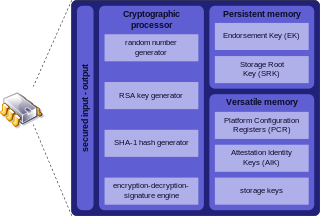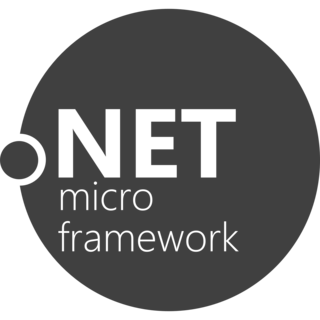
Universal Serial Bus (USB) is an industry standard that allows data exchange and delivery of power between many types of electronics. It specifies its architecture, in particular its physical interface, and communication protocols for data transfer and power delivery to and from hosts, such as personal computers, to and from peripheral devices, e.g. displays, keyboards, and mass storage devices, and to and from intermediate hubs, which multiply the number of a host's ports.

STMicroelectronics N.V. is a multinational corporation and technology company of French-Italian origin. It is headquartered in Plan-les-Ouates, Switzerland and listed on the New York Stock Exchange, on the Euronext Paris in Paris and on the Borsa Italiana in Milan. ST is the largest European semiconductor contract manufacturing and design company. The company resulted from the merger of two government-owned semiconductor companies in 1987: Thomson Semiconducteurs of France and SGS Microelettronica of Italy.
Serial Peripheral Interface (SPI) is a de facto standard for synchronous serial communication, used primarily in embedded systems for short-distance wired communication between integrated circuits.

Unified Extensible Firmware Interface is a specification that defines the architecture of the platform firmware used for booting the computer hardware and its interface for interaction with the operating system. Examples of firmware that implement the specification are AMI Aptio, Phoenix SecureCore, TianoCore EDK II, InsydeH2O. UEFI replaces the BIOS which was present in the boot ROM of all personal computers that are IBM PC compatible, although it can provide backwards compatibility with the BIOS using CSM booting. Intel developed the original Extensible Firmware Interface (EFI) specification. Some of the EFI's practices and data formats mirror those of Microsoft Windows. In 2005, UEFI deprecated EFI 1.10.
OpenMAX, often shortened as "OMX", is a non-proprietary and royalty-free cross-platform set of C-language programming interfaces. It provides abstractions for routines that are especially useful for processing of audio, video, and still images. It is intended for low power and embedded system devices that need to efficiently process large amounts of multimedia data in predictable ways, such as video codecs, graphics libraries, and other functions for video, image, audio, voice and speech.

OMAP is a family of image/video processors that was developed by Texas Instruments. They are proprietary system on chips (SoCs) for portable and mobile multimedia applications. OMAP devices generally include a general-purpose ARM architecture processor core plus one or more specialized co-processors. Earlier OMAP variants commonly featured a variant of the Texas Instruments TMS320 series digital signal processor.
USB communications device class is a composite Universal Serial Bus device class.

FreeRTOS is a real-time operating system kernel for embedded devices that has been ported to 35 microcontroller platforms. It is distributed under the MIT License.
Virtual instrument software architecture (VISA) is a widely used application programming interface (API) in the test and measurement (T&M) industry for communicating with instruments from a computer. VISA is an industry standard implemented by several T&M companies, such as, Anritsu, Bustec, Keysight Technologies, Kikusui, National Instruments, Rohde & Schwarz, and Tektronix.

Trusted Platform Module (TPM) is an international standard for a secure cryptoprocessor, a dedicated microcontroller designed to secure hardware through integrated cryptographic keys. The term can also refer to a chip conforming to the standard ISO/IEC 11889. Common uses are to verify platform integrity, and to store disk encryption keys.
ARM9 is a group of 32-bit RISC ARM processor cores licensed by ARM Holdings for microcontroller use. The ARM9 core family consists of ARM9TDMI, ARM940T, ARM9E-S, ARM966E-S, ARM920T, ARM922T, ARM946E-S, ARM9EJ-S, ARM926EJ-S, ARM968E-S, ARM996HS. Since ARM9 cores were released from 1998 to 2006, they are no longer recommended for new IC designs, instead ARM Cortex-A, ARM Cortex-M, ARM Cortex-R cores are preferred.

The .NET Micro Framework (NETMF) is a .NET Framework platform for resource-constrained devices with at least 512 kB of flash and 256 kB of random-access memory (RAM). It includes a small version of the .NET Common Language Runtime (CLR) and supports development in C#, Visual Basic .NET, and debugging using Microsoft Visual Studio. NETMF features a subset of the .NET base class libraries, an implementation of Windows Communication Foundation (WCF), a GUI framework loosely based on Windows Presentation Foundation (WPF), and a Web Services stack based on Simple Object Access Protocol (SOAP) and Web Services Description Language (WSDL). NETMF also features added libraries specific to embedded applications. It is free and open-source software released under Apache License 2.0.
A Bluetooth stack is software that is an implementation of the Bluetooth protocol stack.

Universal Serial Bus 3.0, marketed as SuperSpeed USB, is the third major version of the Universal Serial Bus (USB) standard for interfacing computers and electronic devices. It was released in November 2008. The USB 3.0 specification defined a new architecture and protocol, named SuperSpeed, which included a new lane for a new signal coding scheme providing full-duplex data transfers that physically required five additional wires and pins, while preserving the USB 2.0 architecture and protocols and therefore keeping the original four pins and wires for the USB 2.0 backward-compatibility, resulting in nine wires in total and nine or ten pins at connector interfaces. The new transfer rate, marketed as SuperSpeed USB (SS), can transfer signals at up to 5 Gbit/s with nominal data rate of 500 MB/s after encoding overhead, which is about 10 times faster than High-Speed. USB 3.0 Type-A and B connectors are usually blue, to distinguish them from USB 2.0 connectors, as recommended by the specification. and by the initials SS.
WinUSB is a generic USB driver provided by Microsoft, for their operating systems starting with Windows Vista but which is also available for Windows XP. It is aimed at simple devices that are accessed by only one application at a time. It enables the application to directly access the device through a simple software library. The library provides access to the pipes of the device. WinUSB exposes a client API that enables developers to work with USB devices from user-mode. Starting with Windows 7, USB MTP devices use WinUSB instead of the kernel mode filter driver.

The Wireless Gigabit Alliance was a trade association that developed and promoted the adoption of multi-gigabit per second speed wireless communications technology "WiGig" operating over the unlicensed 60 GHz frequency band. The alliance was subsumed by the Wi-Fi Alliance in March 2013.
MikroElektronika is a Serbian manufacturer and retailer of hardware and software tools for developing embedded systems. The company headquarters is in Belgrade, Serbia.
The initial versions of the USB standard specified connectors that were easy to use and that would have acceptable life spans; revisions of the standard added smaller connectors useful for compact portable devices. Higher-speed development of the USB standard gave rise to another family of connectors to permit additional data paths. All versions of USB specify cable properties; version 3.x cables include additional data paths. The USB standard included power supply to peripheral devices; modern versions of the standard extend the power delivery limits for battery charging and devices requiring up to 240 watts. USB has been selected as the standard charging format for many mobile phones, reducing the proliferation of proprietary chargers.

USB4, sometimes referred to as USB 4.0, is the most recent technical specification of the USB data communication standard. The USB Implementers Forum announced USB4 in 2019.










